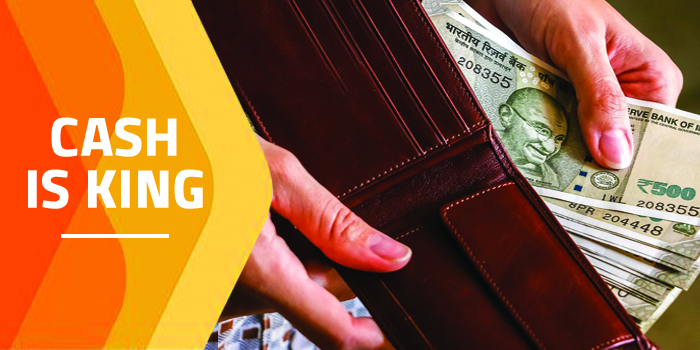Even though digital payments are on the rise, cash continues to hold its throne. In an economy like ours, we are likely to continue witnessing the coexistence of both cash & digital payments
Even though digital payments are on the rise, cash continues to hold its throne. In an economy like ours, we are likely to continue witnessing the coexistence of both cash & digital payments. The Indian economy has been in a constant state of evolution. From using precious metals, cowrie shells, and currency notes to now intangible payment modes such as cards, BHIM UPI, QR codes, and RFID – the payment landscape is evolving at a rapid pace. However, one mode that has stood the test of time is cash.
While India has predominantly been a cash-intensive economy, two events may have challenged the status quo – Demonetisation & Covid-19. They brought about a change in people’s payment habits. Before demonetisation, digital payments were very nascent in India. In just a matter of few years, digital payments have gained extraordinary growth, with the volume of transactions increasing at a CAGR of 36%.
Interestingly, cash in circulation is also now about 14.5% of GDP. According to the data released by RBI, ahead of Diwali, the currency with public rose by Rs 15,582 crore. On a year-on-year basis, it has increased by Rs 2.21 lakh crore. This is an indicator that despite the rising demand for digital transactions, cash has still seen an upward curve.
Let us look at various reasons for this increase:
65.07% of Indians still reside in rural areas
India is a country with a wide customer base coming from urban, semi-urban, and rural areas. Interestingly, the rural population constitutes over 65% of the total population of India. While the penetration of digital payments is deep in metro cities and semi-urban areas, the rural counterparts continue to transact in cash; for which they rely on traditional channels such as the bank branches and ATMs. Newer services such as micro ATMs or Cash@PoS are playing an important role in meeting rural India’s cash needs.
As India is an agrarian economy, it is observed that cash withdrawals increase during the crop harvest season, which is usually between March and April.
Direct Benefit Transfer (DBT)
The value of fund transfers by the means of Direct Benefit Transfer increased from ₹619.4 billion during financial year 2016 to ₹5,525.2 billion during financial year 2021. These schemes enable beneficiaries to receive benefits directly into their accounts. This amount can only be withdrawn using AePS or ATMs, thereby increasing the money supply in the country. Moreover, there are 43.90 crore beneficiaries of the PMJDY (Pradhan Mantri Jan Dhan Yojana). These initiatives will result in increased currency with the public as more people will come under the segment of ‘banked population’.
The pandemic push
During the lockdown, many people withdrew large amount of cash as a preventive measure and to avoid frequent visits to the ATM owing to restrictions during nationwide lockdown. In fact, the average ticket size of withdrawals at any given time went up by almost 20 per cent. While digital acceptance was gaining momentum, there were many merchants who were not equipped to go ‘digital’ completely. This could be because of factors like cost of implementation and lack of awareness among merchants – especially small shop owners & vendors. Hence, customers had continued to make payments in cash for their day-to-day essentials.
Additionally, it was observed that many retailers began offering Cash@PoS services to cater to the increasing cash needs of their customers.
Unbanked population
There are about 15 crore Indians who still do not have a bank account. Moreover, many Indians are daily wage earners – earning their livelihood by the means of cash. All their day-to-day transactions take place by the means of cash.
Regulatory policies
Recently, the Minister of State for Finance Bhagwat Karad said that out of the 2.13 lakh ATMs in the country, 47% are in rural and semi-urban areas. Moreover, the RBI has apprised all White Label ATM operators to deploy minimum 1000 ATMs a year. Such a move will cater to the everyday cash needs of citizens and cash will continue being a primary mode for transacting.
Growing cyber-security concerns
While digital transactions have been surging, many Indians are still sceptical about making large value transactions online. This is due to the rising cyber-attacks and frauds that digital payment modes are exposed to. As opposed to digital payments, cash-based transactions involve only the payer and the receiver; hence, many customers feel it is safer to pay in cash. In a latest report by globally a leading financial technology player, 71% respondents stated that they are concerned about scams and fraud owing to the shift to digital methods of payments due to Covid-19. Additionally, digital payment frauds account for about half of all bank fraud cases in India.
All these factors establish that even though digital payments are on the rise, cash continues to hold its throne. In an economy like ours, we are likely to continue witnessing the coexistence of both cash & digital payments. While the acceptance of digital payments will grow at a rapid pace, cash will continue being the most preferred mode for most Indians in the near future as well.


